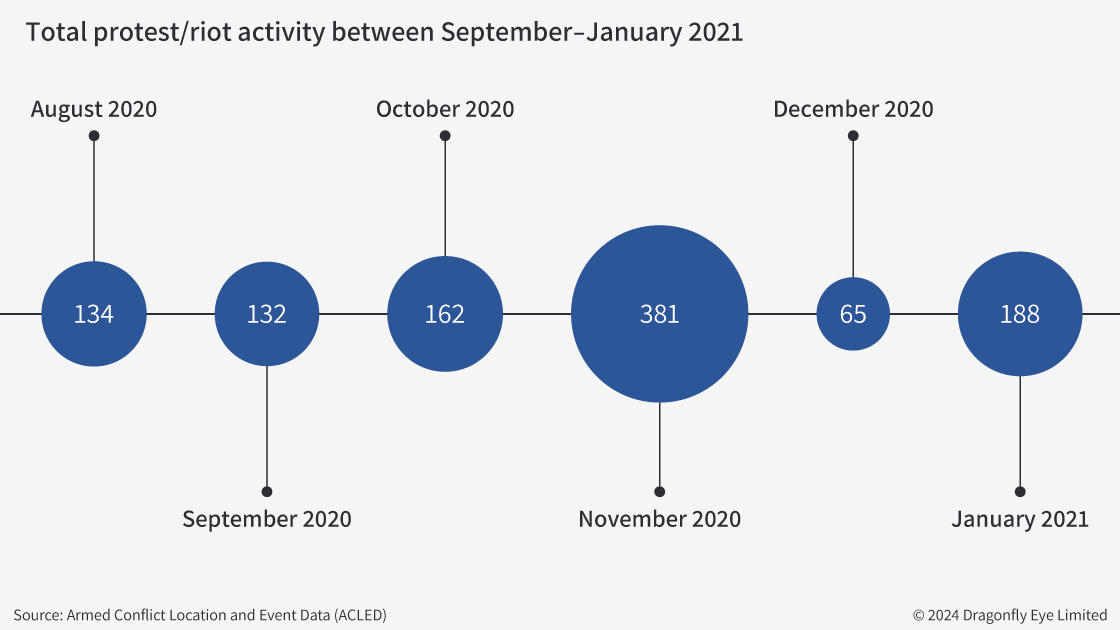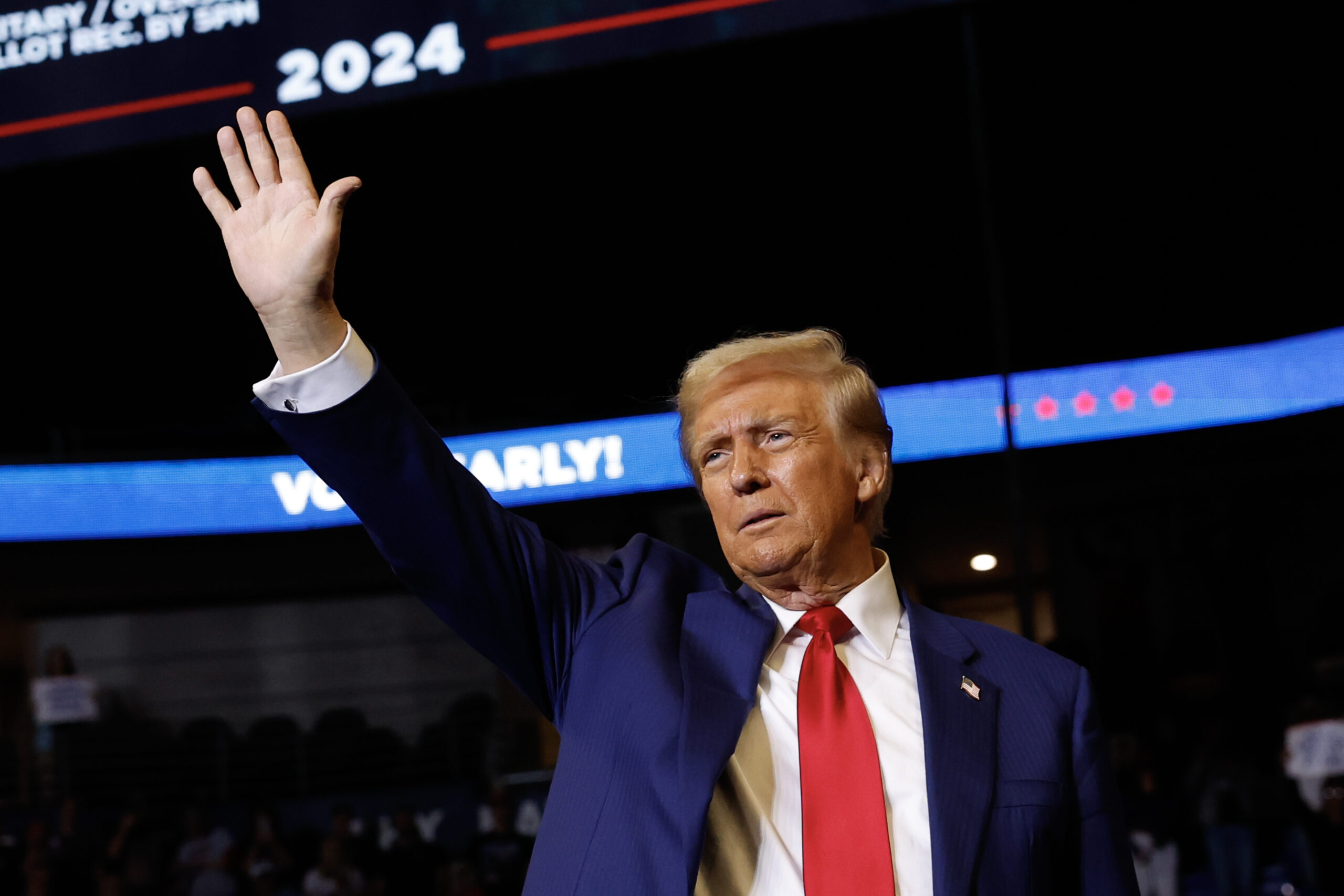If Donald Trump wins the presidential election on 5 November, left-wing extremist violence and protests by activist groups would probably follow
This assessment was issued to clients of Dragonfly’s Security Intelligence & Analysis Service (SIAS) on 11 July 2024.
- The latest polling data suggests that Donald Trump holds a slight lead nationally over President Joe Biden
- We anticipate that protest activity would last for a couple of weeks after the election at most
Victory for Donald Trump in the US presidential election on 5 November would probably lead to left-wing extremist violence and large protests organised by left-wing activists in major cities in the days after. Polling data suggests that the Republican presidential candidate holds a slight lead over the incumbent Democratic candidate, President Joe Biden. Based on the state and national polling data aggregated by the usually-reliable website FiveThirtyEight, Trump currently leads incumbent President Joe Biden by 2.3 percentage points.
To assist clients in their preparedness for the election period, this report sets out what we assess a Trump victory might entail from an operational security perspective. We anticipate left-wing activist activity would last for a couple of weeks after the election. That is also how the 2016 and 2020 election cycle played out; in our view, this year will probably not be significantly different. Inauguration day (scheduled for 20 January 2025) would very likely be the main flashpoint for renewed protest activity and isolated incidents of extremist violence.
Extremist activity likely following a Trump victory
Left-wing extremists will very probably engage in violence on election day. This is particularly if Trump pulls further ahead in the polls. They would also be likely to do so in the days after the vote if he wins. Members of anarchist and anti-fascist groups are particularly active on online channels, though we have not seen any calls for violence around the polls, based on our monitoring of online extremist forums. But these extremists carried out acts of violence around the presidential elections in 2020 and 2016, and they continue to oppose both Donald Trump and Joe Biden.
Incidents of violence during or after the election would probably involve a far-left individual mounting an isolated attack, rather than a high-impact coordinated incident. This is based on the types of violence they have engaged in in recent years. And this is consistent with reports by non-profit groups that have monitored domestic extremist activity in recent years. These findings suggest that these types of extremist groups generally operate in a decentralised manner to avoid law enforcement scrutiny.
Extremists would probably seek to target government buildings, particularly those charged with election-related functions, and law enforcement sites and officers. The DHS 2024 Homeland Threat Assessment said that in general government facilities, polling stations, vote counting sites, and political party offices are among the most probable targets, given their role in the electoral process. Based on incidents of political violence carried out these extremists in recent years, this would probably consist of:
- Arson against election sites, government buildings, and law enforcement sites using improved incendiary devices
- Property destruction and vandalism, including destroying local businesses
- Physically assaulting candidates, election volunteers, government workers, Trump supporters, or law enforcement officers
- Rioting in downtown city centres of large cities such as Atlanta, Chicago, Los Angeles, New York, Portland, San Francisco, and Seattle
Violent clashes between left-wing and right-wing extremists are also likely around the vote. In at least a dozen instances following the most recent presidential election, left-wing groups such as Antifa (short for anti-fascists) fought with far-right groups such as the Proud Boys. Press reports suggest that there were isolated incidents of stabbings and shootings at these. Violent clashes are most likely in Oregon and Washington, given that extremists of both ideologies have a strong presence there. Such violence would also be probable in downtown Washington DC.
Large protests very likely after results are announced
A Trump victory would very likely prompt large protests in the days after the election. The largest of these would be likely to draw several tens of thousands of people in major cities such as Chicago, Los Angeles, and New York, based on anti-Trump protests during the 2016 election cycle. In our analysis, there would probably also be localised protests in states such as Arizona, Georgia, Michigan, Nevada, North Carolina, Pennsylvania, and Wisconsin, given that the results in these swing states have been decisive in determining the outcome of recent presidential elections.
We assess that these protest campaigns would highly likely be led by a broad coalition of left-wing activist groups and Biden supporters. Pro-Palestine, women’s rights, LGBTQ+ rights, racial justice, immigrant rights, environmentalist, and pro-democracy activists are the most likely to hold such demonstrations. These groups would be particularly likely to organise demonstrations in the immediate aftermath of the election; many of them perceive Trump as an existential threat, based on their statements and content on their websites.
Physical clashes between protesters and counter-protesters would also be probable, in our assessment. This is due to the intense social and political polarisation around the presidential election this year. Any small-scale fighting between protesters would be unlikely to escalate to large or widespread physical clashes. This is because officials in most major cities, including Washington DC, have said that they will be on high alert for any potential outbreaks of violence following the election.
Protest activity likely to subside during the lame-duck period
We assess that protests against the election results would probably lose momentum during the lame-duck period (which generally runs from the end of the election to inauguration day on 20 January 2025). As seen in the graph, this was the case during the 2020 presidential election; incidents of election-related protests dropped 83% from November 2020 (381) to December 2020 (65). Instead of continuing prolonged protest campaigns that use up significant resources, most activist groups would probably use this period to strategise on how they intend to push back against Trump administration policies over the following years.

Trump’s inauguration in January 2025 would likely be a flashpoint for protests and counter protests. That is particularly in Washington DC. In this scenario, disquiet around Trump’s domestic and foreign policy agenda would probably drive a sense of urgency among activist groups to mobilise on the day of his swearing into office. We strongly suspect that counterprotesters supportive of Trump would probably confront protesters attempting to disrupt or tarnish the proceedings.
Extremists are unlikely to attend or mobilise around inauguration day in Washington DC. This is because there will almost certainly be a major security plan in place for the day’s proceedings, as has been the case during past inaugurations. And following the storming of the US Capitol on 6 January 2021, there have been official hearings into the security failures that occurred during that day. These have prompted law enforcement agencies to update and expand their planning procedures, intelligence-gathering capabilities and intelligence-sharing practices, based on press reports.
Beyond Washington DC, it is plausible that extremists would mount isolated and localised attacks against state and federal government buildings. This includes sites involved in certifying the election results, courthouses, and law enforcement offices. Still, we anticipate that these sites and local and federal law enforcement will be on high alert for any suspicious or violent activity, given that officials have said that they are preparing for a polarising election period.
Trump’s first 100 days in office
In our assessment, left-wing protest and extremist activity against the Trump administration would only occur sporadically during his first 100 days in office. Protests and acts of violence would most likely be prompted by Trump using his executive power to change policies related to polarising domestic and foreign policy issues. The following actions are ones that would lead to protest and extremist activity during this period:
- Rolling back environmental regulations
- Announcing plans to deport tens of millions of undocumented people, as he hinted at in an interview with Time magazine in April
- Removing protections for LGBTQ+ people and weakening access to gender-affirming health care
- Providing unconditional financial and military support for Israeli military operations in the Middle East
- Ordering the attorney general to dismiss the federal criminal cases against him
- Using his executive authority to pardon himself of criminal convictions
That is based on the issues that left-wing activist and extremist groups have mobilised around in recent years, and campaign promises made by Trump so far.
Image: Republican presidential nominee, former US President Donald Trump during a campaign rally at Bryce Jordan Center on 26 October 2024 in State College, Pennsylvania. Photo by Anna Moneymaker/Getty Images.




